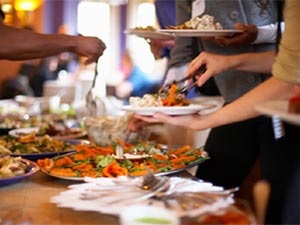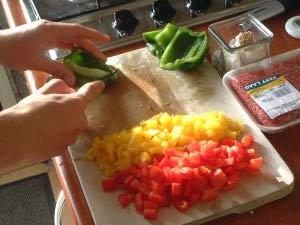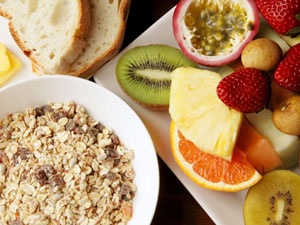 | « Back to article | Print this article |
Want to lose weight? Trick your tummy into feeling full!
The trick to losing or maintaining your weight is to eat less, but feel satiated. Here's how!
Is it possible to eat less and feel full? Most of us enjoy eating as much as we can. But people have now started to realise that it is better to cut down on the intake of large quantities of starchy food. When they actually try to eat less, they find that they feel hungry constantly and are unable to continue with their diets. Very few actually continue to eat smaller portions of food without reverting to their old ways of stuffing themselves with high-calorie treats.
Dieticians have come up with some ways to make us feel full by telling us when to eat, what to eat and how to eat less without feeling starved. They point out that the brain receives the signal that the stomach is full only twenty minutes after a meal and that if we eat too quickly, we will continue to feel like our stomachs are empty, leading to overeating.
is one of the most trusted sources of information about good health and wellness. To those who want to manage their health themselves, LifeMojo provides necessary information, tips, tracking tools and support to help them stay informed and motivated.
Send the right signals to your brain
- Eat slowly and chew properly. Remember, it takes 20 minutes for the brain to realise that the stomach is full. So no matter what you eat, make sure you eat slowly and chew properly to prolong eating time.
- Eat a plate of salad 10 minutes before your main meal so that by the time you finish everything, you will feel full. If you get bored of chewing salads, you can opt for vegetable broths. You can also try a variation of salads. Try making cubes of vegetables, changing the dressing (make sure you choose a healthy low-cal dressing), mixing fruits with vegetables or having a sprout salad.
- Eat frequently and avoid skipping meals. If you happen to skip a meal, there are chances that you will overeat at the next one. Eat in small intervals (every two to three hours), as this will help prevent you feeling overly hungry at meal times. Also, digesting those few calories which you consumed at your mid-meal will rewire the body to remain active and burn some additional calories.
- Finishing everything on the plate is often a sign of fullness. So eat in a smaller plate and the visual cue will signal to your brain that you have eaten a plate full of food.
- Consume entire fruits rather than juices, as fruit juices are stripped of fibre. A whole fruit contains both water and fibre that makes you feel satisfied that you have consumed a sufficient volume of food.
Fibrous foods that make you feel full
Some foods are high in fibre and give the feeling of satiety, although they supply the body with 20 percent fewer calories than low-fibre foods. Fibrous foods -- such as whole grains, fruits and vegetables -- force you to chew harder and longer than fibre-free foods, such as chips or doughnuts. They stay longer in the stomach and you feel less hungry before your next meal.
Replacing some processed foods can help you increase the fibre in your diet. For example, replace the usual pasta with wholewheat pasta, the usual bread with oats or wholewheat bread, refined flour with wholewheat flour (adding bran to it will further increase the fibre content), the usual white polished rice with brown rice and corn flakes in your breakfast cereal with wheat flakes or muesli. High-fibre foods that you should be aware of are:
- Whole grains such as oats, whole wheat products, brown rice, bran, bajra (pearl millet)
- Fruits like oranges, apples, pears, guavas, sweet lime, lemons, grapefruit, berries, pomegranates
- Vegetables such as spinach, fenugreek, broccoli, cabbage, asparagus, capsicum, carrots, pumpkin, gourds
Fruits and vegetables are not only rich in fibre, but they also have significant water content, which makes them low-calorie options. This helps in weightloss and keeps you full for longer at the expense of fewer calories.
Other satiating healthy foods
Other foods that give a feeling of fullness are lean proteins and healthy fats. Researches suggest that proteins have a very good satiety quotient, so make sure you consume some lean (low-fat) protein through skimmed milk, low fat dairy products (like low fat curd, milk powders etc), white meats, baked fish, egg whites, beans, legumes, sprouts and lentils.
Although we avoid as much visible fat as possible, include some healthy fats through various nuts and seeds, which are otherwise also rich in fibre, protein and important vitamins and minerals. These nuts contain omega 3 fatty acids, which have a beneficial effect on the heart and overall health. Using limited quantities of olive oil, mustard seed oil and other PUFA (polyunsaturated fatty acid) vegetable oils will also improve your overall well-being.
Healthy snack options
All snacks do not count as junk food. Some are high in nutrition and provide low calories. They can be taken in between meals to prevent you from feeling hungry. Examples of such mid-meal snacks are:
- Unsalted popcorn
- One or two oats cookies
- Multigrain biscuits
- A small bowl of puffed rice
- Nutritional snack bars
- Fruit juice without sugar
- Roasted channa
- Steamed corn
- Butter milk
- Raw mango panna during summer
- Wheat rusk
- Corn on the cob
Conscious choices prevent you from feeling guilty about eating and snacking at regular intervals throughout the day. They give you the satisfaction of eating and enjoying a variety of tasty foods, supply you with energy all through your work day and put an end to the feeling of being starved and craving for something to eat.




